Going Green
Southeast North Carolina Food Systems— Supporting local farmers
Hiring a Landscape Architect
Friends School of Wilmington
Community Gardens:
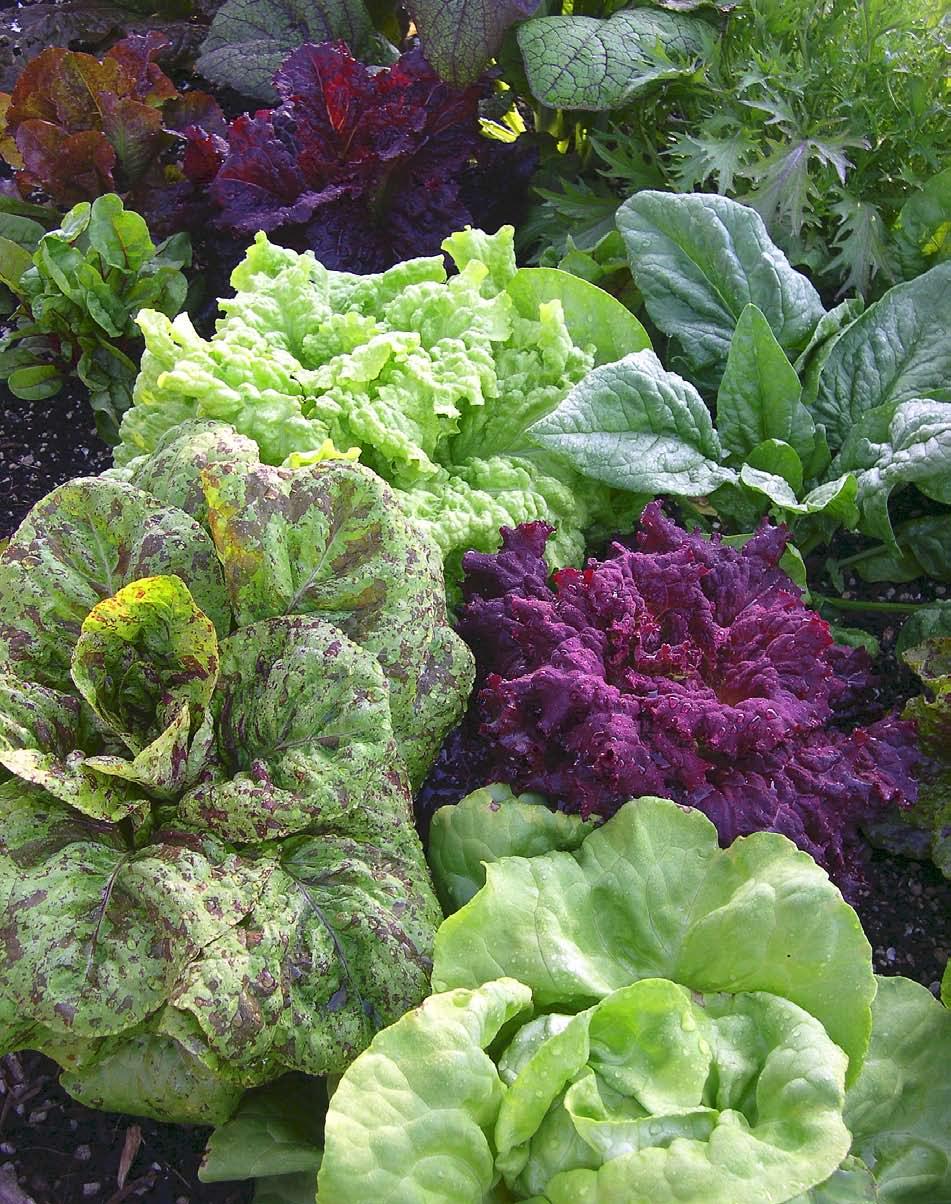
Letter from the Editor
When I signed up for the “Eat Local” challenge at Tidal Creek Coop, I wasn’t thinking about reducing my dependence on fossil fuels. I just wanted to eat fresh, healthful food while supporting North Carolina farmers and retailers.
But recent events in the Gulf force us to rethink the consequences of our actions. One large and unyielding consequence of our love affair with “things” is that in order to continue making and shipping them, we will have to look for oil in increasingly hostile environments, sometimes with disastrous results.
Don’t get me wrong—I’m a fan of capitalism. But capitalism doesn’t mean “just buy more stuff.” Capitalism means making decisions about what and when we buy in order to support and sustain our chosen way of life.
If I buy a pineapple at the grocery store, I’m telling the grocer, and the wholesaler, and the farmer, and the fertilizer company, and the ad company—pretty much everyone—that I want that pineapple, even if it comes from far away. That I want that pineapple despite the fuel needed to bring it here.
Now, signing up for the food challenge was easy; I could make up my own guidelines. So I pledged that all the food I purchased during the month, and particularly anything I took to a potluck event, had to come from this area.
At the grocery store last week I stood in front of the blueberry display—which of the two brands to choose? Normally I’d just look for the nicest berries at the best price. But because of my “eat local” pledge, I examined them more closely: one brand came all the way from Canada; the other from Rocky Point just a few miles north of me. Had I not paused a moment to read the label, I wouldn’t have known one choice would let me support a local farmer, and require less fuel to bring the food to me.
Reducing our dependence on foreign oil can be just that simple. The choices we make with our doIlars do make a difference. Granted, it’s not always easy to determine the best alternative—it might take less fuel to bring something by train from California than by truck from Florida, for instance. And it’s hard to find alternatives for some products that are not produced here—olive oil, for example. Sometimes the best choice can seem elusive.
But if we read the label, we can almost always figure out the better choice.
Valerie L. Robertson Editor
Contents
3 SENC Food Systems Program Supports Local Agriculture
4 Grow Your Own Food—The Joys of Community Gardening
7 Neighborhood Gardens Building Community
8 Friends School Gets Their GOAT—Quaker Ideals Inspire
Environmental Stewardship
10 Hiring a Landscape Architect
12 2010 Wilmington Tree Awards
13 Your Ecological House The Blot Heard Round the World
14 Global Climate Treaty Remains Elusive
14 Global Warming—A Look Inside Copenhagen
17 Education & Business News
21 Faith-Based Environmentalism
23 Stormwater 101—Did You Drop Something? Wilmington
Adopts New Pet Waste Disposal Ordinance
are two spiritual dangers in not owning a farm. One is the danger of supposing that breakfast comes from the grocery, and the other that heat comes from the furnace.”
— Aldo Leopold (A Sand County Almanac)
Cape Fear’s Going Green is a quarterly publication promoting eco-friendly resources and lifestyles in the Lower Cape Fear River Basin.
Publisher & Editor in Chief: Valerie Robertson
Sister City: Eugene, Oregon (Voted “Greenest City” 2006 by The Green Guide) Eugene Contributing Editor: Mary Robertson
Advisors & Editorial Contributors: Jennifer Butler, Nicole Carpenter, Vanessa Haugh, Leslie Hossfeld, Brinkley Hutchings, Daniel Kay, Alexei Kouminov, the Kuuskoski family, Jaimie Lang, Karen Linehan, Adeline Robertson, Jane Steigerwald, Philip S. Wenz.
Cape Fear’s Going Green Going Green Publications
P. O. Box 3164
Wilmington, NC 28406 (910) 547-4390
www.goinggreenpublications.com
Cape Fear’s Going Green is available by subscription or on our Web site. Print copies are available at more than 140 area eco-friendly businesses and locations, including:
Angela’s Pepper-Pickled Foods, B + O Design Studio, Old Growth Riverwood, Pomegranate Books, Port City Java, Progressive Gardens, Sambuca, Sapona Green Building Center, Tidal Creek Co-op, UNCW, WHQR, and the Shelton Herb Farm booth at area farmers’ markets.
Editorial: If you have story ideas or calendar items to suggest, email us at editor@goinggreenpublications.com, or call (910) 547-4390.
Advertising information: Email ads@goinggreenpublications.com.
Cape Fear’s Going Green is distributed for free through Brunswick, Columbus, New Hanover, Onslow, and Pender counties. If you have a business and would like to receive multiple copies for the public to pick up, please contact us.
“There
feast on the southeast
SENC Food Systems Program Supports Local Agriculture
SENCFS Creates Ambitious Range of Programs to Address Nutrition, Poverty
Across the country, people are starting to ask questions about their food. Where does it come from? Who grew it? Was it genetically modified? Fertilized with toxic chemicals? Was the farmer paid a living wage? How far did it travel to get to my table? Increasing dissatisfaction with global agribusiness and awareness of the toll “traditional” agricultural methods are taking on the earth is prompting interest in “eating locally.”
In our area, the “Southeastern North Carolina Food Systems Council” (SENCFS) has been at the forefront of the local food movement since 2006, founded by Dr. Leslie Hossfeld of the UNCW Public Sociology Department and Mac Legerton of the Center for Community Action in Lumberton. SENCFS began in response to the massive job loss and high poverty in southeastern North Carolina—an eight-county area that despite its rich agricultural heritage, remains persistently poor. A partnership of private and public institutions, the group provides a variety of programs aimed at keeping local food dollars, well…local. By matching area farmers with local restaurants, schools, healthcare facilities and military bases, SENCFS is helping forge relationships that will benefit both sides of the equation. By developing a regional food system, the group hopes residents will have access to
SENCFS recently received a grant for $375,000.00 from the GoldenLEAF Foundation to establish a Local Food Processing & Distribution Center in Warsaw; they also received $25,000 from the North Carolina Tobacco Trust Foundation to support the Processing & Distribution Center efforts.
SENCFS has partnered with James Sprunt Community College to add an adjoining Processing & Distribution Center to their Commercial Kitchen plan. The Processing & Distribution Center will function as a hub for small farmers—a place where farmers can pool their resources and products to meet the needs of the growing local food market. Restaurants, schools, hospitals and other institutions will be able to go to one source for fresh local produce and other foods.
safer, fresher foods and farmers will find more sustainable markets for their products. By creating relationships between those who grow food and those who consume it, SENCFS hopes to stabilize and sustain the region.
The group’s “Farm to Chef” Initiative has been successful in connecting area chefs with local farmers— often considered a crucial partnership. The group’s first Farmer-Chef Dinner— held at Catch restaurant in Wilmington last February—was immediately filled to capacity. Organizer Jane Steigerwald, SENCFS Assistant Program Director, was delighted with the positive response. “Participants were thrilled to have made connections they never would have made, had it not been for the dinner.” In addition to meetings and events, farmers and chefs are encouraged to make use of the online “Farm to Chef Directory” at www.feastsoutheastnc.org. Establishments interested in increasing their local food purchases and farmers interested in selling to local chefs may be included in the directory by contacting Jane Steigerwald at steigerwaldj@ uncw.edu.
Nutrition is key for growing minds; SENCFS has several programs geared to increase access to nutritious foods for the area’s youth, ranging from community gardens to cooking classes to helping farmers obtain the certification they need to sell produce to schools.
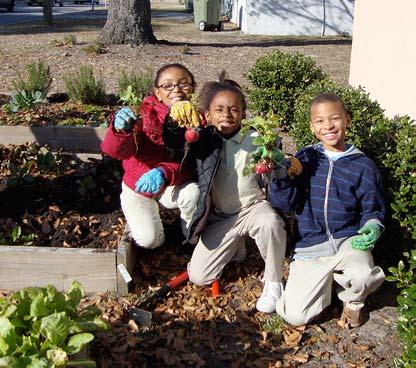
Budgetary concerns, regulations and red tape can make it challenging for school administrators to make use of local food suppliers. It’s often easier to fall back on large, familiar national vendors. By part-
nering with community and government agencies, SENCFS has created several farm-to-school programs that work with the school’s Child Nutrition Directors to come up with local solutions. Recent grants awarded will help the group create an onsite processing center that will allow local farmers to flash freeze some of the region’s prized agricultural products: blueberries, strawberries, and potatoes. “Bringing fresh local vegetables and fruits into our county schools would be the ultimate reward for our farmers and community,” says Dr. Hossfeld.
The demand for local food is gaining momentum as consumers realize the benefits of buying locally: fresher and more healthful products that require less fuel to transport. The challenge is finding ways to connect the market with the consumer. Partnering with community and government agencies has enabled SENCFS to make great strides in meeting this challenge.
To get involved with SENCFS activities or sign up to attend the next quarterly meeting, visit www.feastsoutheastnc.org.
Grow Your Own Food—The Joys of Community Gardening
”What are we doing today?” Steve Lee hears the same question every Tuesday in Folk’s Community Garden. “Today,“ he answers, “We’re weeding that tomato bed.”
The volunteers look doubtful. “How do you know what’s a weed?” someone asks hesitantly. Lee reassures him, “Everything
except the tomatoes is weeds. I’ll show you. ” He shares a trick: “That little fork rake loosens the soil up, too, which makes handpicking them out easier.”
The day’s volunteers set to work, picking up speed as they gain confidence. “You stay as long as you want,” says Lee. “I’ll be here ‘til about seven.”
By the end of the evening even the beginners can tell a tomato seedling from a weed, and beds are clean and ready for the next planting. “Good job” laughs Lee. “It looks like a different place!”
With increased awareness of the benefits of nutritious, locally-grown fruits and vegetables, more and more people want to be involved in growing their own food. Those who have the space and know-how can garden at home. But many have limitations: no land, no sun, or—for many—no experience growing vegetables. Participating in a community garden offers a solution.
Kathryn Sisler and Courtney Matheson harvest carrots from Folk’s Community Garden.
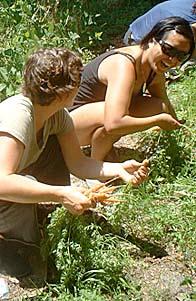
Volunteering at an existing garden is a great way to get a feel for the kind of garden you might like to start yourself. Here are some in Wilmington with openings.
Folk’s Community Garden
1300 block Princess Street
Communal and individual plots
Steve Lee • stephen.lee@nhcs.net
Castle Street Community Garden
4th & Castle Streets
Communal plots
www.meetup.com/seacc-ilm
Kathryn Sisler • kathryn.sisler@gmail.com
Sisler is also available to advise anyone with an interest in starting a new garden. (908)670-1590
Beach Road Farm Community Garden
222 Heathcliff Road, Monkey Junction area
Individual plots for rent
www.beachroadfarm.com
Julie Congleton (910)409-2336
A community garden is a piece of land gardened collectively by a group of people. Some are designated for a single community, such as a school or a development; others invite anyone who wants to participate. The structure can be tailored to the community it serves, and reflects the interests of those who tend it. If the gardeners have an appreciation for organic food, they’ll be willing to take the extra time to hand-weed instead of spraying pesticides. Gardens also vary in intent: while many focus on food production, Birch Creek has a centrally-located flower garden for all to enjoy. Hillcrest Community Garden, a SENCFS project, helps schoolkids learn about growing healthful food.
Gardening appeals to all ages. When Buddy Milliken developed Woodsong, a sustainable neighborhood in Shallotte, he included community garden space for residents to grow good food and enjoy shared activities. To his surprise, the first to sign up was a seven-year-old girl; she still participates regularly. It’s not unusual for gardeners to bring their children to help at garden work parties; on any given day three generations of people might be pulling weeds, watering, and tending plants together.
The Castle Street Community Garden yields both vegetables and medicinal herbs. The Echinacea shown here thrives in the sandy soil whether or not soil amendments have been applied. Herbalism classes taught at the Community Action Center next door frequently involve a trip into the garden, to examine plants first-hand.
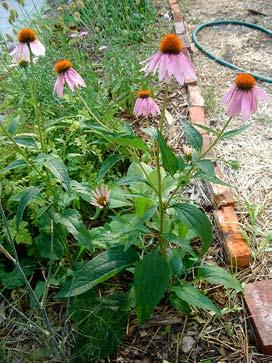
During a Folk’s Community Garden work session
Steve Lee positions a bean trellis he fashioned of bamboo, wood and twine. “This is where old Boy Scout skills come in,” he volunteers. photos this article by Valerie Robertson (continued on page 5)
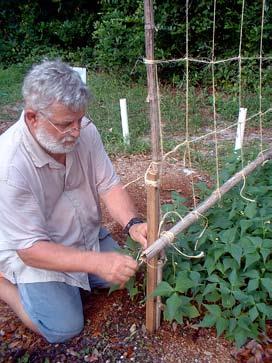
community gardens
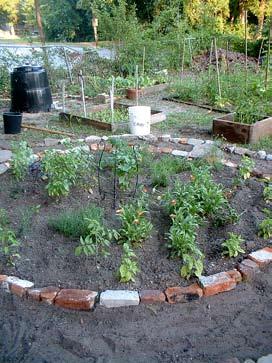
Getting Started
When herbalist Kathryn Sisler was asked to start the community garden on an urban lot on Castle Street, she had a lot of choices to make. A project of the Southeastern Alliance for Community Change (SEACC), whose efforts to strengthen communitybuilding and social justice helped set the tone for the garden’s development, it came about when a sympathetic landowner offered access to the vacant lot next to the group’s community center. They also agreed to supply water. But questions remained— Who would do the work? Would it be open to the community at large or just neighbors within walking distance? What would they plant? Where would the seeds or starts come from? Would decisions be made by consensus or by committee? How would they use the resulting food? Would each volunteer have an individual plot, or would everyone work the whole garden communally?
Armed with a strong background in herbalism and with community gardening checklists she’d found on the internet, Sisler scheduled an organizational meeting and invited everyone she knew. The volunteers she attracted were of like mind: they would use no pesticides, they would garden the
area communally, and offer the food to the surrounding community.
The result: Castle Street Community Garden. Anyone can come grow vegetables and medicinal herbs. Members keep costs low by seeking donated seeds, manure and building materials and using simple mulches of straw and cardboard. All plots are held communally. Volunteers can work any time, but regularly scheduled work sessions ensure that routine tasks get done and that new gardeners receive any coaching needed.
At first members discussed instituting a sort of point system: those who worked the most hours would receive a corresponding share of the harvest. In practice, it works out for volunteers to just harvest food when it’s ready; what they don’t take home, they deliver to neighbors. “Over time, those who are here the most are here when food’s ready to harvest,” says Sisler. “It all works out.”
Community Garden Resources
North Carolina Cooperative Extension www.ces.ncsu.edu
“Home Vegetable Gardening,” publication #AG-06, is one of numerous useful online guides to gardening.
American Community Gardening Association (ACGA)
www.communitygarden.org
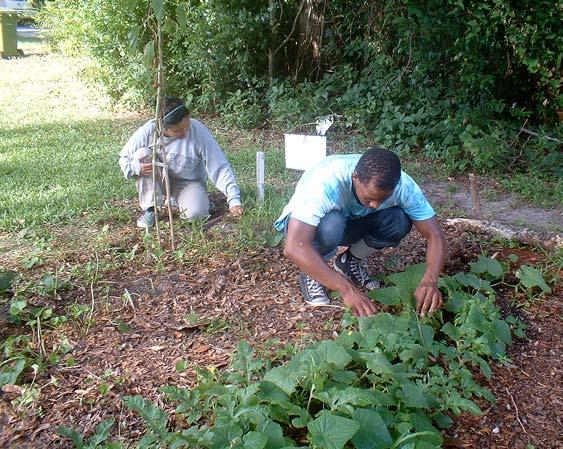
Information on starting gardens, with detailed checklists to help make sure you don’t overlook anything important.
Rebel Tomato
www.communitygarden.org/rebeltomato
Hosted by ACGA, this offers fun information on learning to grow your own food.
Food Not Lawns International
www.foodnotlawns.net is the movement’s website, moderated by Heather Flores.
Books we like
Food Not Lawns: How to Turn Your Yard into a Garden and Your Neighborhood into a Community, by Heather C. Flores
The Wooster Street Community Garden was started on the site of an empty lot for sale; tilling the soil for new beds turned up a variety of construction debris. Volunteers sorted the debris and made creative use of old bricks, concrete rubble and other finds to edge garden plots and walkways.
Beach Road Farm Community Garden
The nine-acre Beach Road Farm Community Garden in Monkey Junction
(continued on page 6)
Food Not Bombs, by Keith McHenry and C.T. Butler.
Carrots Love Tomatoes: Secrets of Companion Planting for Successful Gardening, by Louise Riotte. For those who have mastered some basics.
community gardens
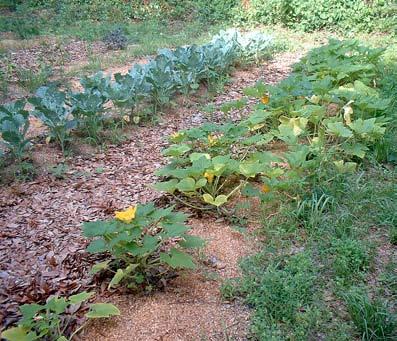
offers a different experience. Renting one of its 20' x 20' lots at $12/month offers plenty of room for production. It’s a great set-up for those who want to do their own work, although organizer Julie Congleton notes gardeners do like to share information on site. “And people often sign up with a neighbor, to share the responsibility.”
Folk’s Community Garden
Steve Lee and Kathryn Sisler started Folk’s Community Garden, also a project of SEACC, as a school project: a neighbor across the street from New Hanover High School loaned the
empty lot, another neighbor provides water. Lee and Sisler developed an interdisciplinary program. Students researched plants, planted and tended the garden during the school year—picking up credit in math, biology and English along the way.
At the end of the school year, the garden was opened to the community. Some opted to rent individual plots, others were interested in the communal experience found at Castle Street, so the garden now offers both options.
Even seasoned gardeners enjoy the opportunity for community gardening.

Rain barrels donated to Castle Street Community Garden now provide most of the water required. For a brief time during a work session, they served as a temporary parking place for that day’s harvest of kale. Orange Butterfly weed flowers attract butterflies and bees to pollinate plants.
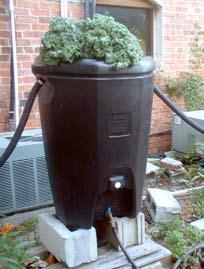
Veteran gardener Angelika Lacer can garden on a much bigger scale at Folk’s than she can at home. “I have the sunshine and the space there, and the camaraderie—that’s a big, big piece, too. It’s really nice to meet others that are interested in sharing expertise.”
And although she now has space at home for her garden, Christina Chiarchiaro continues to help out at Castle Street. She enjoys the community aspect, and helping others learn as she did at the beginning. “What better way to learn than to actually do it and have

somebody overseeing it so you can ask questions along the way.”
Even though community gardens range from large to small, from private to public, they tend to share some characteristics. One common challenge is keeping momentum. “You start out with a lot of interested people in the beginning, but it’s the coming back every day that’s difficult to maintain,” says Lee. Lacer agrees. “There’s a lot of enthusiasm to start with but then the endurance part can be difficult.”
Gardeners agree, though, that the rewards are worth it.
Rows of vegetables in the Folk’s Community Garden, planted by students in the spring, were tended and watered daily through the summer heat by members of the community who signed up to participate in a watering schedule. As part of a three-year plan to build up the soil, walkways between the rows are covered with compost, then cardboard, then a layer of leaves. The layers suppress weeds, and weeks later evolve into mulch that can be turned into the vegetable rows in the spring. (continued on page 7)
community gardens
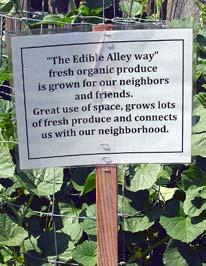
Lacer is looking forward to fall, when leafy greens grow well and cooler temperatures make chores easier. She finds gardening teaches “Patience, and tolerance and a little bit of faith in...whatever. There are so many aspects to it that we don’t include in our busy lives anymore, especially young kids. I think when they come across something like nature and interact with it, it really adds an important piece in their life.” An occupa-
Garden Essentials
What do you need to get started?
• a piece of land (and permission to use it)
• 6 or more hours of sunshine on at least part of the land
• a source of water
• people to do the gardening
• someone knowledgeable about gardening
• materials: tools (and a safe place to keep them), soil, soil amendments, edging or fencing material, and plants or seeds
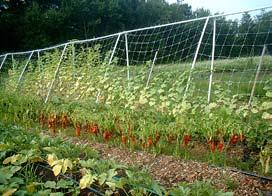
• an organizational approach and a plot plan
• system for gardeners to communicate

tional therapist with the school system, she looks forward to introducing her students to the community garden this fall.
Sisler says she is pleasantly surprised by how much support there is for community gardening in the area. “If you have the energy and dedication it will happen.” At the Carolina Place–Ardmore Neighborhood Association‘s July meeting two dozen neighbors showed up, all with garden savvy and all wanting to get involved in community gardening.
For Chiarchiaro, it’s being surrounded with other volunteers, “like-minded people who don’t mind getting their hands dirty, like learning about plants, have a general focus on eating healthfully, buying locally.”
It’s Tuesday, and a new volunteer is eying the plot he has just adopted at Folk’s Community Garden. “What can I plant?“ he wants to know.
“Go to the North Carolina Cooperative Extension Service website: they have a
Community Building Oregon-Style
At first glance, Annie and Chris Donahue live in a typical Eugene, Oregon home: a modest house with a large vegetable garden out back, a compost heap, and a handful of chickens scratching behind the rain barrels. The front yard, brimming with
Veteran gardener Amy Finelli got her first taste of gardening organically when she planted 600 chilies in her plot at Beach Road Farm Community Garden. She plans to make powders to sell to local restaurants. Soccer goal components support the beans.
list and all the planting dates…” Lee starts listing the vegetables, not wanting to send the newcomer away without an answer. ”Winter squashes, greens, spinach, almost all of the hardy greens like kale, collards; carrots and radishes. There’s a lot of stuff that can go in now.”
ornamentals and cheerful signs, is inviting in any of the mild seasons. But a closer look shows something more happens here: community.
Annie had been mowing the grass alongside their side fence, facing an alleyway, for years, when she decided to plant food there instead. Now the row holds a dozen towering tomato plants and fifty feet of green beans. A clay flowerpot dispenses plastic produce bags next to a sign inviting neigh-
bors to pick vegetables for dinner on the way home.
photos and story by Mary Robertson This issue’s cover shot may look like it hails from an organic truck farm—but it is right out of someone’s front yard. Chris (seen here watering) and Annie Donahue plant vegetables in the sidewalk strip in front of their house and encourage neighbors to pick a salad to take home for dinner. Their efforts have expanded to include the alley alongside their house and the 40' by 80' lot across the street, now a bustling community garden that helps connect and feed the neighborhood. See http://www.eugeneweekly.com/2010/07/15/ gardening.html for more on the Common Ground Garden.
On almost any summer evening Annie and Chris can be found out front watering, weeding, and letting folks know that yes, it is OK to pick the vegetables. A steady stream of neighbors drive, walk, and cycle home through the quiet streets. They all seem to know Chris and Annie. Those who don’t, aren’t strangers long. “Sure, come on by. These beans need to be picked!” Annie shows a neighbor boy how to find the ripest beans, then how to check the temperature of her corner compost bin. Another family heads home, hands full, ready to cook dinner.
“We built the street-side garden thinking it would satisfy the neighborhood’s need for fresh organic vegetables,” says Annie. “What we found is it satisfied our need for neighborhood connection and growing community.”
education
Friends School Gets Their GOAT
Quaker Ideals Inspire Environmental Stewardship
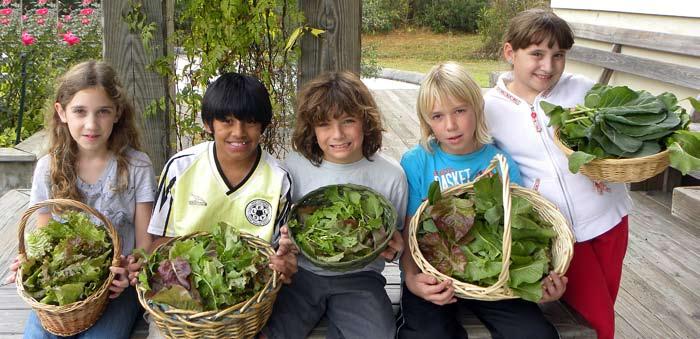
collaborative, with an emphasis on building relationships between the school and the Wilmington community. All students, from kindergarten through eighth grade, participate in weekly service work that begins at school and extends into local communities and the world.
Established in 1994, Friends School has grown to include two campuses (Peiffer and Pine Grove) on eight combined acres.
by Karen Linehan, Jaimie Lang, Jody Ellis and Susan TurnerIt’s four o’clock on a cold, January afternoon. All of the students have gone home for the day. Around the corner from the school’s front door, a small group of teachers surveys a scruffy plot of grass and exposed soil. Even in the chilly wind, the teachers are smiling as they look beyond the dormant landscape. Coming soon to this location is the next project of GOAT (Green Outdoor Adventure Team), a faculty committee at Friends School of Wilmington. Working with students and parent volunteers, GOAT hopes to transform this little patch of grass and dirt into a verdant garden of delights for birds and other wildlife.
Although native gardens are at the top of the list at Friends School, GOAT is following an ambitious agenda of other green initiatives and adventure programs. As part of the school’s “5-Year Strategic Plan,” the committee is evaluating everything from eco-friendly control of fire ants to reusable dishware and green cleaning products. With an adventure playground
already in place, GOAT is also planning a low ropes course and fitness trails around the grounds. In addition, the committee is expanding the school’s longtime camping program and dreams of establishing an educational working farm with chickens and goats (the inspiration for the project’s acronym).
And GOAT is motivated by more than a strategic plan and an earnest work ethic. Infusing each project are the Quaker values upon which the school is founded: simplicity, peace, integrity, community service, equality, and stewardship of resources. “Getting children outside so they can experience the natural world is a major goal of our Quaker curriculum,” explains art teacher Sharon Ely. “This helps children develop an intimate feeling of belonging in nature, and ultimately encourages environmental stewardship, appreciation of beauty, and the ability to find joy in the simplest of things.” Carson, in the first grade, agrees. “My favorite thing is watching the bluebirds flying back and forth from a tree and down to their nest.”
Committee decisions are reached through consensus. Projects are deeply
Over the years, teachers, students, and parents have worked together to create and enhance native habitats for wildlife and learning. Students don’t have to travel far to experience the life cycles of butterflies and frogs, observe bluebirds caring for young, discover earwigs in a rotten log pile, and smell the crushed leaves of wax myrtle. The students love this proximity: “I’ve gotten closer to worms, caterpillars, and butterflies,” says second-grader Charlotte. Preschool teacher and Division Head of School Jane Lawrence notices this, too. “In the morning on the way into school, young children pull their parents to the plants along the sidewalk and excitedly show them a flower or bug,” says Lawrence. “With heads bent together, they are fully experiencing this wondrous ecosystem.”
GOAT hopes to develop outdoor learning environments where children can experience the natural world every day at school. Each classroom adopts several garden areas to study and cultivate—and even to learn in. Art students draw inspiration from the native bog garden that surrounds a pergola-covered classroom, Spanish and music classes are often taught
outside where students enjoy fresh air and sunshine. “Unless it is too wet, windy or cold, classes meet every day in our new outdoor studio,” says Ely.
In order to sustain gardens and build community partnerships, GOAT supports local businesses and often receives donations of plants and landscape materials. In turn, the gardens give back tenfold as they inspire student learning, conserve wildlife and native plants, and feed students and others in the Wilmington area.
ers manage a butterfly garden and plant milkweed as a nectar and host plant for Monarch butterflies. Taylor, in second grade, sums up the program with elegant simplicity: “I like to plant milkweed for the monarchs so that they can live.” This year the milkweed was locally grown by Shelton Herb Farm, Growing Wild Nursery, and the Ability Garden at New Hanover County Arboretum.
Fifth- and sixth-grade students conduct research and nurture saltmarsh plant seedlings in a school yard nursery for the NC Coastal Federation’s Student Wetland Nursery Program. Students work with the Federation to plant the seedlings at shoreline restoration sites along the coast. “Students from the Friends School have planted over 7,500 plants during their involvement with this program”, stated the Federation’s coastal education coordina-
Examples of ongoing stewardship are found at every grade level. Preschool and kindergarten students deposit lunch scraps in classroom worm bins and add the rich vermicompost to backdoor flower and herb gardens. First- and second-gradtor and biologist Ted Wilgis. “The teachers, students and school are incredibly enthusiastic and dedicated to local environmental stewardship.”
organizers strive to get the students outdoors every day. Surrounded by trees, grass, and sunshine, these fifth- and sixth-graders are learning to find their place in nature. •
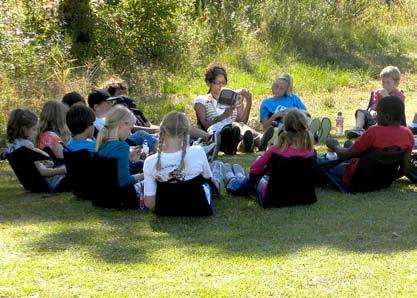
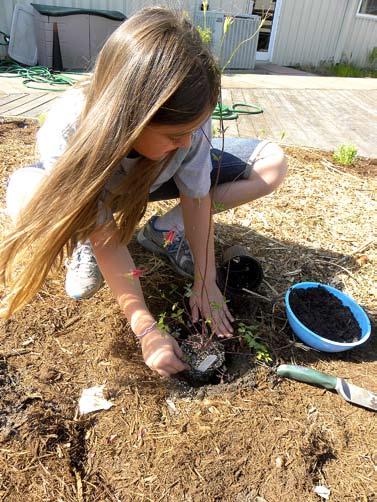
With seedlings donated from local businesses, third- and fourthgraders tend organic vegetables; the resulting harvest helps feed the area’s hungry (see photo). Seventhand eighth-graders focus on water and soil conservation, maintaining several rain gardens on campus that help minimize stormwater runoff.
In addition to community donations, grant funding from local and state organizations such as Cape Fear Garden Club and NC Beautiful have also supported garden development at Friends School.
Seeking various certifications provides motivation and a framework for designing native habitats. The school’s Pine Grove campus is certified as a Nature Neighborhood by the North Carolina Museum of Natural Sciences, a Schoolyard Habitat by the National Wildlife Federation, and a Monarch Waystation by Monarch Watch.
It’s four o’clock on a warm, spring afternoon. All of the students have gone home for the day, their hands and clothes a little dirtier than when they arrived at school this morning. Thanks to their hard work, Friends School has a new garden habitat for birds. The students have planted American beautyberry, “hearts a’bustin,’” and dwarf palmetto to provide fall berries for songbirds. Crossvine, penstemon, coral honeysuckle and columbine will offer spring nectar for hummingbirds. Most important, the school’s gardens will cultivate life-long connections between children, wildlife, and the world around them. It is the dream of GOAT, and Friends School of Wilmington community, that these simple gifts from the garden will inspire a new generation of environmental and community stewards.
Karen Linehan, Jaimie Lang, Jody Ellis and Susan Turner are all enthusiastic teachers and members of GOAT.
Learn more about Friends School of Wilmington and its programs at www.fsow.org or call (910)791-8221 or toll free at (888)644-3769.
landscape architect

Hiring a Landscape Architect—
Wilmington Celebrates New River
The “Top 50” Career You Have Never Heard Of
by Lara Berkley“What are the best flowers to plant in my yard?” is often the first question a landscape architect fields during casual party conversation. While most could answer it, they are capable of addressing much more complex design issues. Landscape architects design a wide array of projects, ranging from golf courses to cemeteries, zoos and hiking trails and community gardens. They also help shape commercial and residential development—as well as civic infrastructure.
Most people have heard of Frederick Law Olmsted, who designed New York City’s Central Park and is regarded as the founder of modern landscape architecture, but designers such as Ian McHarg have also influenced the American design landscape. His 1969 book, Design With Nature, helped to establish a new direction based on ecological principles and protection of natural
resources. If you have traveled the Blue Ridge Parkway, explored a National Park, walked through a college campus, visited the Washington Mall, or picnicked on the new High-Line Park in New York City, you have experienced the work of a landscape architect.
The breadth and diversity of this field—as well as the country’s increasing concerns about land use, resources and sustainability—has helped the profession make the US News and World Report’s “50 Best Careers” list for 2010.
Rigor
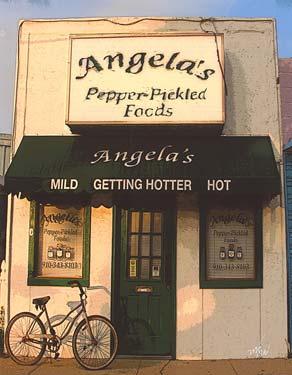
Landscape architects are trained to analyze, plan, design, and oversee construction of outdoor spaces. Throughout most of the United States, including North Carolina, they must hold a state-issued certificate of registration to be able to practice and to use the title “Landscape Architect.” In order to become state-registered, aspir-
Diversity
The River to the Sea Bikeway (WMPO Bicycle Route 1) is an 11-mile, on- and off-road bicycle route that follows the Historic Beach Car Line, which carried vacationers from downtown Wilmington to Wrightsville Beach by trolley. The bikeway comprises neighborhood residential streets, off-road multi-use paths, and a few busy arterial roadways.
Although registration recognizes a set of common skills, such as site layout, grading, drainage, plant knowledge, circulation design, and land-use issues, there are plenty of opportunities for specialization. Some landscape architects have a background in horticulture, while others might pursue a degree in ecology, sociology, or geography.
It begins at the foot of Market Street at the Riverwalk, within sight of the Battleship USS North Carolina. The bikeway then traverses the Old Wilmington, Bottom and Forest Hills neighborhoods before crossing Independence Boulevard and passing by Empie Park. From Empie Park to South Kerr Avenue, the bikeway follows Park Avenue, a quiet local street that passes by Audubon Station.
After merging with South Kerr Avenue and crossing South College Road, the bikeway passes through the
ing practitioners generally must have an accredited degree in landscape architecture, work for several years for a registered landscape architect, and must pass a registration exam. To keep their license they must continue to learn throughout their career.
Two Events Celebrating the Bikeway
Many landscape architects work alone; others work on teams with architects, engineers, ecologists, and urban planners. While some work exclusively at the residential scale—designing planting areas, fountains, arbors, decks, and paths—others focus on larger projects such as golf courses, planned communities, brownfield remediation, or zoo exhibits. A landscape architect working for a city planning office might provide input and oversight for large civic projects; these require a detailed understanding of land-use patterns, cultural influences, pedestrian and vehicular circulation, and municipal codes.
Winter Park area on Pine Grove and McMillan Avenue, before up with Park Avenue again. Between Wallace Avenue and 52nd Street, bikeway utilizes an off-road spur to the University of North at Wilmington (WMPO Bicycle 1A) via Wooddale Drive. Between Street and Hinton Avenue, the follows on-road bicycle lanes Avenue. Beyond Greenville Avenue, ride is much more uncomfortable recreational cyclists. Oleander Wrightsville Avenue are busy roadways with few bicycle facilities high-speed traffic, and there eral bridges to cross. This section recommended for recreational
Access and Parking
Ann Street Bicycle Boulevard Grand Opening Celebration
Celebrate the opening of the fi rst bicycle boulevard in North Carolina with Mayor Bill Saffo on April 17, 2010 at 10:00 a.m. at the Martin Luther King, Jr. Community Center on So. 8th Street.
River to the Sea Ride
Take part of a free group bicycle ride from downtown Wilmington to Wrightsville Beach and back on May 1 at 8:30 a.m., starting at the foot of Market Street in downtown Wilmington.
Some newer subdivisions have begun to require residents consult a professional to ensure their landscaping meets the standards and codes for that area. A residential customer starting with a complicated site, for instance one with a steep grade or existing wetland, could also benefit from the comprehensive perspective of a landscape architect. More recently, landscape architects have been involved in ecological restoration: assisting ecologists in efforts to re-establish wildlife habitat, create
To reach the downtown trailhead, follow U.S. Highway ward Wilmington; take the Wilmington DOWNTOWN exit. Proceed south North 3rd Street. Take a right Street and follow west to Riverfront Parking is available on-street city of Wilmington parking deck at Market Street and North 2nd The bikeway begins at the foot Street at Water Street. Follow Route 1 signs.
To reach the Empie Park follow U.S. Highway 76 to Independence Boulevard northbound. Take Park Avenue and an immediate the park driveway. The bikeway Avenue. Follow the bicycle Route
landscape architect
urban wildlife corridors, or repair damaged ecosystems.
A typical process?
Regardless of the scale, every landscape architect follows the same general pattern. This starts with a site analysis, which may be as simple as walking the site and collecting soil samples, or as complex as helping prepare an extensive environmental impact statement. Understanding the existing conditions and surrounding context are critical to the design process, and an effective landscape architect will ask many questions before ever putting a pencil to paper or opening a drafting program.
Skilled communication is important—an effective landscape architect is able to express design ideas both verbally and graphically. Their final product might simply be an artist’s rendering for a marketing campaign. Or, the landscape architect might be responsible for a complete set of construction documents outlining tree
preservation, grading and drainage; construction of walls, fences, and decks; and detailed planting plans. Many landscape architects also oversee site installation: that is, ensuring that contractors construct and install the landscape according to the requirements of the design.
Working with a landscape architect
In North Carolina, one can go to the NC Board of Landcape Architects to find a registered practitioner. Most landscape architects also have websites that describe their specialty. As when hiring any specialist, it’s worth a visit to the local Better Business Bureau to confirm the professional reputation of a firm or individual.
A common misperception is that landscape architects provide only planting designs and minimal layout advice late in the game. Hiring a consultant early in the process can often save money. For example, by establishing building locations and code
Native Plant Society Plant Walks
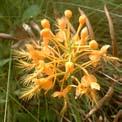
Keeping current in one’s field can extend far beyond subscribing to trade journals. Lara Berkley helps organize plant walks for the SE Coast chapter of the NC Native Plant Society, like this one led by orchid expert David McAdoo through the Green Swamp in August. Learning the habits of native plants in the wild helps equip her to incorporate natives successfully in landscape designs.
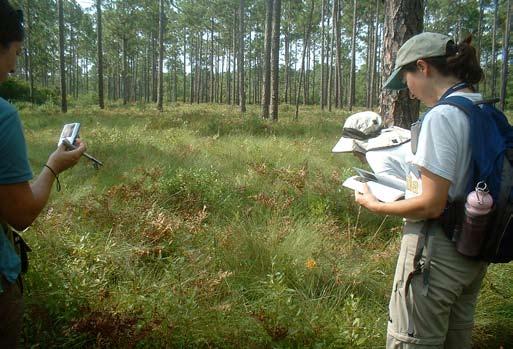
restrictions and designing drainage solutions early on, a skilled architect can help minimize site disturbance, reduce excavation costs and save mature trees and other desirable natural features.
Is landscape architecture a ‘green’ profession?
Most landscape architects have chosen their profession because of its unique combination: art, science, and for many, a deep appreciation of nature. Almost all landscape architecture degree programs now teach “sustainable” design, which emphasizes the interconnection between people and the landscape and the responsibility to create and maintain a healthy environment. Just like other design professions, in practice there are shades of green, or relative degrees of sustainability.
Landscape architecture is by nature a profession of observant planners. If you are thinking of doing anything with your land, consider hiring a landscape architect at the beginning of your efforts—you will be rewarded richly by the scope and creativity of solutions she or he will contribute.
Lara Berkley ASLA is co-owner of B+O Design Studio in Wilmington, NC. She can be reached at (910)251-2707 or at her company’s website: www.b-and-o.net.
Online Resources
American Society of Landscape Architects (ASLA) – professional association www.asla.org
Sustainable Sites Initiative www.sustainablesites.org
The Sustainable Sites Initiative™ (SITES™) is an interdisciplinary effort by the American Society of Landscape Architects, the Lady Bird Johnson Wildflower Center at The University of Texas at Austin and the United States Botanic Garden to create voluntary national guidelines and performance benchmarks for sustainable land design, construction and maintenance practices.
North Carolina Board of Landscape Architects – professional registration http://ncbola.org or 919-850-9088
Suggested Reading
American Landscape Architecture, Designers and Places c. 1989, National Trust for Historic Preservation in the United States Design with Nature 1969 Ian McHarg
New River to Sea Bikeway
area on Pine Grove Drive Avenue, before joining Avenue again. Between Avenue and 52nd Street, the utilizes an off-road path, with a University of North Carolina (WMPO Bicycle Route Wooddale Drive. Between 52nd Hinton Avenue, the bikeway on-road bicycle lanes on Park Beyond Greenville Avenue, the more uncomfortable for cyclists. Oleander Drive and Avenue are busy arterial few bicycle facilities and traffic, and there are sevcross. This section is not for recreational cyclists.
Parking
owner wanted to reduce lawn and create a birdfriendly and accessible landscape as well as a sound and visual buffer to nearby streets. The design incorporated existing trees and new plantings, including blueberry, yaupon holly, inkberry holly, Florida dogwood, redbud, winterberry, water oaks, laurel oaks and many others. This property is a fine example of conservation landscape and does not require irrigation or pesticides.
staff and the joint efforts of the City of Wilmington, the trees were relocated in various areas on the museum’s grounds. All of the trees survived the move.
Outstanding functional design
New Hanover Regional Medical Center –
Betty H. Cameron Women’s and Children’s Hospital
City of Wilmington 2010 Tree Awards
the downtown Wilmington follow U.S. Highway 74 toWilmington; take the Wilmington exit. Proceed south on Street. Take a right onto Market follow west to Riverfront Park. available on-street or in the Wilmington parking deck located Street and North 2nd Street. begins at the foot of Market Street. Follow the bicycle
the Empie Park parking area, Highway 76 to Independence northbound. Take a right onto and an immediate left into driveway. The bikeway is on Park Follow the bicycle Route 1 signs.
Vegetables
Plants
Leland
Outstanding pruning and maintenance; Outstanding tree restoration
2502 Market Street
Owner: Jon and Michelle Carne
Landscape: Tex Floyd
To reach the Wrightsville Beach trailhead, follow U.S. Highway 74 toward Wrightsville Beach. At the intersection of Salisbury Street and North Lumina Avenue, continue straight on Salisbury Street to the on-street parking area. The bikeway begins on Salisbury Street west of North Lumina Avenue. Follow the bicycle Route 1 signs. There is also additional parking at the Wrightsville Beach municipal complex at the intersection of Salisbury Street and Seawater Lane.
For more information, contact the Wilmington Urban Area Metropolitan Planning Organization (WMPO), which is the regional transportation planning agency for the lower Cape Fear region of southeastern North Carolina. Write WMPO at P.O.Box 1810, Wilmington, N.C. 28402, call (910)341-3258 or visit www.wmpo.org.
On behalf of the Wilmington City Council, The Wilmington Tree Commission annually presents awards in up to nine categories, for properties located within the city of Wilmington. The awards and criteria for nominations recognize outstanding tree preservation, outstanding landscapes, and outstanding commitment to tree maintenance. In 2010, the Wilmington Tree Commission recognized seven proprties in six categories.
This property has experienced tremendous hurricane damage over the years, but the owners have consistently restored and replanted after each storm to maintain the beauty of the existing plantings on this property and to replant same species when required. There are 40-year old Azaleas and Camellias, 50-year old Dogwoods, and 100-year old Pines.
Outstanding pruning and maintenance; Outstanding tree preservation
5014 Wrightsville Avenue
Owner: Inman Park, LLC
Site Designer: Brad Sedgwick
Landscape Architect: Josh Milaly
Information above provided courtesy of www.rivertoseabikeway.com.
Arborist: Connolly Tree Service
This property was developed under a special use permit in an O&I zoned area. The design contemplated creation of a wooded buffer area along a common property line and preservation of two large oak trees. The large oak trees ensure plenty of shaded area on the site and an inviting pedestrian area. Numerous features were incorporated in this site to reduce runoff and overall impact, create walking paths and aesthetically pleasing property.
Outstanding Tree Preservation
Cameron Art Museum
Outstanding Functional Design
218 Bretonshire Drive
Owner: Maggie Parish
Site Designer: Sandy Wood
June 10 is the deadline for our Summer 2010 issue
Owner: Louise Wells Cameron Art Museum
Property Manager: Johnnie McKoy
Arborist: Akers & Parker Tree Movers, Inc.
Owner: New Hanover Regional Medical Center
Landscape Design: Mott Landscaping / Steve Mott
This property is a rare example in the City of rooftop habitat for people and wildlife. Due to height and weight considerations, the site utilizes dwarf varieties of native trees such as Gem Magnolias, Japanese Maples, and Forest Pansy Redbud. The trees were planted in large containers that will lie down in the event of a hurricane. All trees are located in drip zones operated by a central controller that automatically adjusts for seasonal changes.
Outstanding use of native trees
Wilmington Riverfront Project
Site Owner: Plantation Building Corporation
Site Designer: Coastal Site Design
Landscape Architect: Neal Taylor/One World Design
The site developer’s commitment to planting trees is evidenced by the fact that even before construction of buildings the developer planted large, wellformed, but slow-maturing trees to be enjoyed now and by future generations.
Outstanding naturalized plantings; Design appropriate to site
University of North Carolina Wilmington
Site Owner: State of North Carolina
Site Design and Landscaping: UNCW
Landscape Services
Superintendent: Robert Warren
This project began in the early 1990s and has been a work-in-progress for many years. The property

Editor@goinggreenpublications.com or call (910)547-4390
The widening of Independence Blvd. required proactive measures to ensure the viability of ten Live Oaks planted along Independence Blvd. Due to the efforts of the museum’s Property Manager and
To preserve and ensure the viability of the Long Leaf Pine forest located throughout the UNCW campus, the division of Landscape Services has embarked on a series of succession plantings of Long Leaf Pine, including as many as 500 seedlings planted in the past three years. This is just one example of the good works being done by Landscape Services at UNCW. The UNCW Landscape Services plants, maintains and cultivates a wide variety of plant life on campus and has created a beautiful, pedestrian and wildlife environment that will be around for us to enjoy for a very long time.
Photos of the award winners can be seen in the video of the awards presentation, held at the City Council meeting on June 1, 2010. Visit http://wilmington.granicus.com/ MediaPlayer.php?view_id=25&clip_id=2250 (Note: the presentation starts 9 minutes 30 seconds into the video.)
Nominations for tree awards are accepted year-round; details are available at the City of Wilmington website.
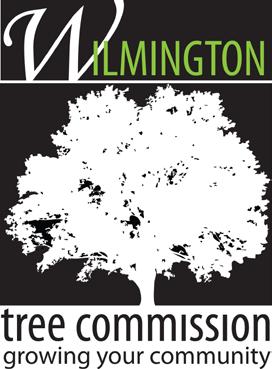
Please do business with our advertisers. And remember to thank them for their support of Going Green.
your ecological house™
The Blot Heard Around the World
by Skip WenzIt is fascinating, in a ghastly way, to track the growth of the Deepwater disaster in the Gulf. It’s like watching cancer spread throughout your child’s body.
The event that started as an oil-rig fire that incinerated 11 workers soon led to the collapse of that rig and the report of a minor oil leak a mile below the ocean’s surface. That “minor leak” quickly morphed into a major gusher that couldn’t be stopped—exposing the lie that today’s technology has made deepwater drilling safe.
Exposed, too, is our government’s complicity in this disaster. The relentless flow of oil into the Gulf has been paralleled by the flow of disclosures about corruption in the Interior Department and the ongoing collusion of the government in BP’s public relations and legal-cover campaign to hide the scope and effect of the spill.
But this disaster is just too big to contain. It’s now threatening the long-term productivity of one of the world’s great fisheries; the solvency of the world’s thirdlargest corporation (BP); Anglo-American economic relations; the global financial recovery; our faith that government can protect us from disaster; and the myth of U.S. energy-independence via domestic fossil-fuel extraction.
Worse, there is no end in sight for this catastrophe. Although BP finally began capturing some of the flowing oil two weeks ago, and hopes to be able to siphon most of it by the end of June, the upcoming hurricane season could thwart that effort.
More significantly, some independent scientists are questioning the efficacy of the “final-solution” relief wells scheduled for completion around the end of August. Possible damage to the well head or its surrounding geologic structure could render the relief wells useless. If that happens, we’re out of solutions—there is no known way to stop the gusher.
It is sobering in this regard to consider how the oil-soaked birds in the Gulf die. When exposed to the semi-tropical sun,
they are slowly cooked to death inside their tar-and-feather casings—thousands of them.
It’s easy enough to hate BP. Their greed, arrogance and reckless behavior are the proximal causes of the spill. But we are all stuck in this dysfunctional system. BP is merely a symptom of a disease called fossil-fuel dependence. And they are operating in the fever-consumption stage of the disease—the era of peak oil.
“Peak oil” means that we’ve used up half of the world’s oil reserves. If you envision a bell curve depicting the total amount of oil that was available when we began large-scale petroleum extraction in the 1800s, there is a midpoint on that curve—the peak—at which half the reserves are used and only half remain. (This applies to any nonrenewable resource.)
Once the peak is reached, the half that remains rapidly becomes more expensive, but not just because there is less of it; in the case of extracted resources such as oil, most of the easy-to-get stuff disappeared before we reached the peak around 2005.
The remaining oil must be extracted from increasingly remote and hostile environments. This is particularly true for the U.S., which used up its “easy” oil decades ago, then became dependent on foreign oil, and now finds that its remaining domestic supply is in, well, deep water.
Our dilemma can be summarized as an expression of the law of diminishing returns customized for energy supplies—the principle of EROEI, energy returned on energy invested. At the beginning of the industrial petroleum era, oil wells typically returned a lucrative EROEI of 12 to 14 times as much energy as it took to drill and operate them. Today, wells return an average of 1.5 times the energy invested,
and sometimes they return less energy than they consume.
Silhouetted against the backdrop of peak oil, the Deepwater disaster is at least comprehensible; entrenched powers are desperately trying to keep their impossible fossil-fuel game going. What is incomprehensible is that we need an event on the scale of Deepwater to give us a wakeup call.
There is an expression from the 1960s that I still see on the occasional bumper sticker: “NATURE BATS LAST.” It’s worth contemplating at your ecological house.
© Philip S. Wenz, 2008
Philip S. (Skip) Wenz is a freelance writer specializing in ecological design issues. He was a general contractor, residential designer, teacher and writer in the San Francisco Bay Area. In the early 1990s he founded, and for ten years directed, the Ecological Design Program at the San Francisco Institute of Architecture. He also teaches “Creating Your Ecological House,” at Berkeley’s Building Education Center and wrote the book, Adding to a House (Taunton Press, 1995).
Skip now lives with his wife, Pam, in Corvallis, Oregon and divides his time between various writing projects and retrofitting his older home to be more environmentally friendly. He may be reached by email through his Web site at www.your-ecological-house.com.
underlying roof, the roof is less subject to UV damage and the normal expansion and contraction of its waterproofing membranes.
Global Climate Treaty Remains Elusive
Copenhagen Talks Result in Few Agreements: Developing Countries, Dismayed, Point to “Leadership Crisis” Among Industrialized Members
by Vanessa HaughThe newly installed green roof atop the hospital is filled with 30-40 species of local native plants, which will require little or no maintenance once established. The growing medium is much lighter in weight than soil, and allows for good drainage; excess rainwater is stored for future garden use. Signage planned for the garden will allow children to learn about the plants they find in the garden.
Winter / Spring 2010
World leaders convened in Copenhagen last December to design a global climate treaty aimed at lowering global warming pollution. The United Nations Framework Convention on Climate Change (UNFCCC) hoped to create the successor to the Kyoto Protocol, set to expire in 2012. when office: promised top of later, steps by setting targets nor specifying the amount of money to invest in cleaner and greener economies in developing nations. The United States is the second-largest emitter of global warming pollution and the number one per capita, consuming 36% of the world’s energy while comprising only 5% of the world’s population.
The hospital’s garden is one of the first of its kind in the WIlmington area. It was designed by Steve Mott of Mott’s Landscaping, a locally-owned, LEED-certified company, tailored to the performance goals of the hospital. Learn more about rooftop gardens and see photos of other projects at www.mottlandscaping.com.
zeroVOC PAINT, FLOORING, INSULATION and more...



716 S. 17th St. Wilmington
www.saponagreen.com
• 910.762.1505
• OPEN M-F 10-5, Sat 12-4
as told to Nicole Carpenter
Brinkley Hutchings, an Environmental Science student at the University of North Carolina Wilmington and president of the UNCW Environmental Concerns Organization (UNCW ECO), was chosen to represent U.S. youth at the UN Framework Convention on Climate Change. Recently, I had the opportunity to speak with her about her experiences in Copenhagen.
Can you provide a brief description of what took place in Copenhagen?

Last December, United Nations delegates convened in Copenhagen for the 2009 UN Framework Convention on Climate Change (UNFCCC). The goal of these recurring meetings is to “[prevent] ‘dangerous’ human interference with the climate system” by negotiating interna-
RENEWABLE ENERGY
solar, wind and geothermal
WATER CONSERVATION
An overwhelming majority of scientists agree that humans are affecting the global climate by creating greenhouse gases, primarily in the form of carbon dioxide produced by burning fossil fuels. The warming trend of recent decades has resulted in melting of ice caps and a corresponding rise in sea levels, as well as other far-reaching effects.
CONSERVATION ENERGY
low-flow fixtures, rainwater harvesting
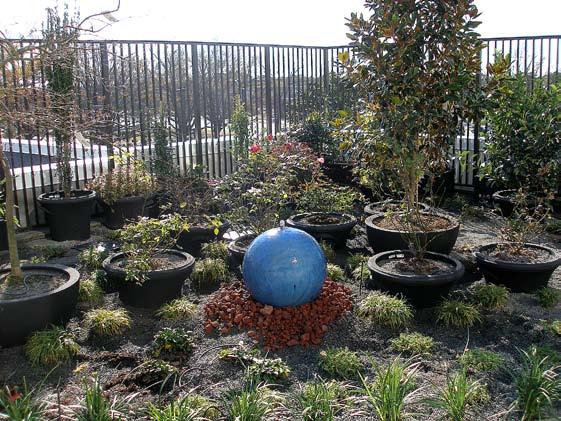
sustainable, recycled & non-toxic materials counters by Icetone, floors by Plyboo & Teragen, paint by Safecoat
INTERIORS
INTERIORS
716 S. 17th Street
Wilmington NC 28401 910.762.1505

www.saponagreen.com





OPEN M-F 10-5, Sat 12-4

11 Cape Fear’s Going Green
Small island states in particular are united in their commitment to reduce emissions—and in their disappointment in the United States and other industrialized nations for their inaction. President Nasheed of the Maldives, a striving to remain above sea Copenhagen treaty in bold terms: “Let’s be very frank about this: Copenhagen can be one of two things. It can be an historic event where the world unites against carbon pollution, in a collective spirit of co-operation and collaboration. Or, Copenhagen can be a suicide pact. The choice is that stark.”
(continued on page 15)
A Look Inside Copenhagen UNCW Student Selected to Represent U.S. Youth at Recent Climate Change Discussion
tional treaties that set binding goals for meeting environmental standards.
What was your role at the Convention?
I was the US representative for the Greenpeace (GP) Student Network on a team with 40 other student activists from 14 different countries, including France, China, Brazil, Philippines, and Germany. For a week prior to the negotiations, we worked together raising awareness in the city and supported each other while we lobbied our respective delegates. During the convention, we attended the talks daily to ask questions and hold delegates accountable.
Who was at the convention?
Five hundred young adults from the US comprised the largest youth delegation and there were thousands of youths from other countries, too. People of all
(continued on page 16)
Global Climate Treaty Remains Elusive continued
Despite cries from activists around the world for a fair, ambitious, and legally binding treaty, Copenhagen ended largely in failure. A day of talks between 115 world leaders produced eight drafts but no treaty. President Obama and Chinese Premier Wen Jiabao were left to strike a political agreement. The resulting Copenhagen Accord “recognizes” the case for keeping temperature rise to no more than two degrees Celsius, past which most scientists agree would result in unchecked, catastrophic climate change, but it does not contain any binding commitments to reduce emissions. In particular, low-lying countries likely to be most affected by a rise in the sea level were disappointed by the lack of commitment to emission cuts that were originally designed to hold global temperature rise to 1.5 degrees Celsius this century.
At the last minute all references to the 1.5 degree goal were removed; the goal of reducing global carbon dioxide emissions by 80% by 2050 was also removed. The accord does provide $30 billion through 2012 for adaptation and mitigation
projects in poor countries; this amount increases to $100 billion by 2020. Member nations have promised more than the $30 billion mark to date, although some questions remain regarding the exact nature of the pledged funds.
On the last day of the talks Greenpeace International Executive Director Kumi Naidoo blamed a lack of effort, particularly by industrialized nations, for the failure to produce a treaty. “We have seen a year of crises, but today it is clear that the biggest one facing humanity is a leadership crisis,” said Naidoo.
Lumamba Di-Aping, Sudanese diplomat and chief negotiator for the G-77 group of 130 developing countries, also expressed his disappointment at the talks as showing “the lowest level of ambition you can imagine. It’s nothing short of climate change skepticism in action. It locks countries into a cycle of poverty forever. Obama has eliminated any difference between him and Bush.”
President Obama assured that negotiations were not over, saying, “we
have come a long way but we have much further to go.”
Member nations met in Bonn, Germany in April and in June 2010 to continue the talks. According to the UNFCCC, nations made progress in forming the final package of operational measures that will be presented at the UN Climate Change Conference in Mexico November 29-December 10 of this year. However, industrialized countries are still not doing enough, said de Boer. “Take all current pledges and plans from all countries and we still won’t stop emissions growing in the next 10 years.”
For more information, read:
http://unfccc.int/2860.php = United Nations Framework Convention on Climate Change site

http://www.350.org/ = information on worldwide efforts to reduce carbon emissions
http://www.guardian.co.uk/environment/2008/nov/10/maldives-climatechange = article on efforts by Maldives to buy a new homeland before theirs is overrun by the rising sea
Climate Change: One Student’s Perspective
by Alexei KouminovMany people have heard how much they have done to hurt the environment in their lifetimes and how we have ruined the earth’s atmosphere from driving cars and polluting the oceans, destroyed large areas of forest and driven many animals to extinction. But even the smallest things can have a huge difference on our environment. But one person cannot save the earth, we must all work to bring an end to Climate Change.
we would no longer need to kill trees; we could just use the paper we had made before. Schools could provide classes about climate change to make the next generation more earthconscious. At home, we can take smaller showers and only use the dishwasher and washer when they are full.
UNCW student and environmental activist Brinkley Hutchings, at the December 2009 climate talks in Denmark. Selected by Greenpeace to be the sole representative of the Greenpeace Student Network from the U.S., she spent two weeks lobbying delegates and networking with fellow activists from around the world.
By the time we are three we have already used thousands of sheets of paper and plastic, in the form of diapers. From the age of five to eighteen we use tens of thousands of sheets of paper for school. And for an entire school you need millions of sheets of paper. And for all schools around the world you need trillions of sheets of paper, killing around two million two hundred trees every year.
Of course this paper is required, but if every single school would recycle then
We can keep the doors open on hot summer days and closed on cold days. Students could ride their bikes or carpool with each other to save money and gas. Like drops of water filling a water basin, many small things can add up to a solution for a large problem.
Alexei Kouminov wrote this while a 7thgrade student at Myrtle Grove Middle School. He chose the issue of climate change as the focus of his year-long study project. He wrote a research paper, gave presentations to three schools, planted trees, volunteered at a nursery, and created a website. This article was written to fulfill his final assignment, which was to raise public awareness.
A Look Inside Copenhagen
continued from page 16
ages attended, representing the diverse interest groups of civil society, from animal rights and social justice organizations to water issues and natural disaster groups. [The climate movement] is now the largest social movement in global history. People are finally becoming aware of the urgency with which we need to address climate change.
What did you learn from your peers?
So much. I realized just how much the rest of the world is looking to the US to show leadership and significantly reduce their emissions. We are the largest emitter of greenhouse gases per capita. We are the ones that need to make a move. Also, some African governments had sent students to the conference, encouraging the participation of youth in decision-making processes. They actively collaborated with their delegates at the end of each day. This differs from the U.S., where youth often feel shut out.
What was your experience like at the conference?
Going into the first week of talks, I was pumped, determined to push our delegates to show progressive leadership at these negotiations. I prepared my questions for the day’s talks and arrived early so that I was first in line. I was determined to ask why we weren’t showing leadership at
these negotiations and why we weren’t doing what the science claims is necessary to avoid the worst effects of climate change. And I was going to get answers, damn it!
Many youths asked tough, pointed questions. After stumbling over our first few, mediators stopped calling on us in front of global media. This, I believe, is for fear we would reveal that our “world leaders” were not doing all they could to protect the future of humanity. To top it all off, during the second week of talks, civil society was not allowed in the conference center at all! They claimed it was a security issue but this has never happened before in conference history. Usually, the plenary is packed by civil society. Their presence puts pressure on delegates and holds them accountable. They removed the transparency of the process by keeping us out. I was boiling. I could touch the door behind which decisions were being made that were deciding my future, the world’s future, but I couldn’t go in. It was outrageous. Based on your observations, were the climate negotiations successful? Did they meet your expectations?
[The negotiations] were a complete failure. I went to Copenhagen with hope that President Obama would do something big. He made promises during his campaign that addressing climate change would be
Solar-Powered Generators Power Nonprofit Events
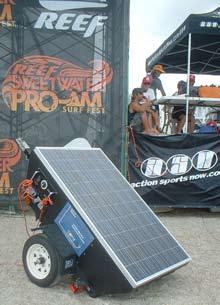
Mack Coyle has designed a silent, solar-powered mobile generator. Housed in a street-legal trailer, it provides 3,000 watts of pure sine wave alternating current. It’s just the thing for providing quiet, clean power for any remote location.
In July Coyle brought the device onto the beach, to power the 6th Annual Reef/ Sweetwater Pro-Am Surf Contest at Wrightsville Beach. Surfing enthusiasts—typically champions of a clean environment—were pleased to avoid the noise, fumes, and toxicity a diesel generator would have brought to the party.
Coyle’s invention is seen increasingly around Wilmington, powering music events day or night. Recently he has been providing area charitable organizations use of the generator for free. If your nonprofit would like some help going green during its next event, contact Coyle Industries at mack@coyleindustries.com.
a top priority. And he had the power at Copenhagen to override Congress, through the Global Climate Protection Act. He could have committed to an aggressive reduction in carbon emissions, and inspire the rest of the world to do the same, but he didn’t. It was so depressing. After reflecting on it, though, I found strength in it all. I realized how many activists are working across the globe, how huge this movement is. I came home ready to fight harder and push for a rapid clean energy transition.
As president of the Environmental Concerns Organization at UNCW, have your experiences and knowledge gained changed the goals and actions of ECO this year?
Our goal before Copenhagen was to pressure Obama to sign onto the climate agreement and to surpass Congressional goals for carbon emissions reductions. From the negotiations I learned that the corporate coal and oil industries are acting as roadblocks to progressive energy and climate change policy. So, the new goals of ECO this year are to work towards removing those roadblocks. We started a relationship with Progress Energy’s regional vice-president, Bob McCall, and generated hundreds of calls to their office, urging them to raise their renewable energy targets and to withdraw from the American Coalition for Clean Coal Energy.
Has your trip to Copenhagen changed your plans and/or goals for the future?
This experience definitely broadened my perspective. Climate change has become a lot more tangible to me. I’ve made friends in other countries where the effects of climate change are already being felt: famines, droughts, sea level rise. My friend Leah in Fiji is watching her country and culture slowly go under water. Abigail, from the Phillipines, her family has been dealing with severe flooding due to climate change. The fact that my country’s way of life is having a negative affect on the livelihoods of others has strengthened my dedication to this movement.
ECO hopes to get more of the community involved with their endeavors. Information on public meetings, to be held in the Tidal Creek Community Center, will be posted on the ECO website: www.uncweco.com.
education & business news
Call for Environmental Education Research Manuscripts
A new international academic journal is scheduled to start publishing this fall. The International Electronic Journal of Environmental Education (IEJEE–Green) will publish research papers on all aspects of environmental education. By making such research freely available to the public, they hope to support a greater global exchange of knowledge. If you have research you wish to publish, see www.iejeegreen. com/index.php/iejeegreen/index.
NC Sustainable Building Design Competition
Cape Fear Community College’s Team Atlantis was second place winner of the 2010 NC Sustainable Building Design Competition.
This year’s design problem was to design an 880SF house for a Katrina-ravaged neighborhood in New Orleans. Competition rules required the house to be built on 8-foot pilings and be accessible to the elderly couple who would occupy the home. The home had to be designed to 140mph wind standards, cost less than $100,000, and fit the context of the Broadmoor neighborhood. The NC Sustainable Building Design Competition is a component of the USGBC Natural Talent National Competition.
Led by Ron Wilson, Architect and Architectural Technology Program Director, Team Atlantis consisted of Lisa Ball, Chancey Drew, Bryan Gillespie and Charles Hagler—all Architectural Technology Graduates. Ball presented the team’s awardwinning design at the August meeting of Cape Fear Green Building Alliance.
Sapona Green Building Center
Sapona Green Building Center welcomes new employee Laura Flessner, who is starting her master’s in Environmental Studies at UNCW after completing her undergraduate courses at Virginia Polytechnic Institute and State University. Laura managed and helped initiate Stormwater Rain Garden Education Program through Cape Fear River Watch, and was a design consultant with Stevens Fine Homes of Wilmington.
CFCC Offers Sustainability Technologies Program
From energy efficiency to solar panels, green technology is spreading into more businesses than ever before. To prepare students for careers in the growing number of green industries, Cape Fear Community College is offering a new academic program in Sustainability Technologies. The program has started this fall with a full class of students.
The program is designed to train students for jobs in environmental, construction, alternative energy, manufacturing, or related industries, where key emphasis is placed on energy production and waste reduction along with sustainable technologies. CFCC students have been exploring green technology for years with a wide variety of projects. The new degree program will expand greatly the sustainability expertise available in our region.
“As businesses become increasingly more green-savvy, we need to make sure our students have access to the latest trends and technology so that they can stay competitive in the job market,” said Bob Philpott, CFCC’s Dean of Technical and Vocational Education.
The Sustainability Technologies program is available in two tracks: A two year Associate in Applied Science Degree and
a fifteen-hour Certificate. The program will focus on alternative energy, green building technology and energy use analysis. Additional topics include sustainability, environmental science, waste reduction, renewable energy modeling, site assessment and environmental responsibility.
Graduates should qualify for careers within the alternative energy, design, construction, environmental, and/or manufacturing industries. Employment opportunities exist in both the government and private industry sectors where graduates may function as energy managers, sustainability consultants, alternative energy installers, environmental technicians, green building supervisors, or entrepreneurs.
“The new Sustainability Technologies program will combine comprehensive knowledge of sustainability with in-depth analytical and technical training to prepare students for a wide variety of green industry jobs,” said John Wojciechowski AIA, LEED AP, the Lead Instructor for the program.
For more information about CFCC’s new Sustainability Technologies program, email jwojciechowski@cfcc.edu or call (910)362-7761.
The New Wilmington Comes to Wilmington
Capt. Doug Springer and partners have brought a new 46-foot catamaran to Wilmington, a sleek new option for exploring the history and ecology of the Cape Fear River. Operating under Wilmington Water tours, LLC, the Wilmington can carry up to 49 passengers on eco-tours, historic tours, and cruises along the upper and lower Cape Fear River. Private charters are also available. Reservations can be booked at www.wilmingtonwatertours.com or by calling (910)338-3134.
Doug Springer, Diane Upton, Mary Delollo and Garland Valentine are proud co-owners of the Wilmington, new addition to the Cape Fear. The specially-designed catamaran offers daily cruises from downtown Wilmington to Carolina Beach, Southport and Bald Head Island. Come see her at the Cape Fear Riverwalk; she docks at 212 S. Water Street.
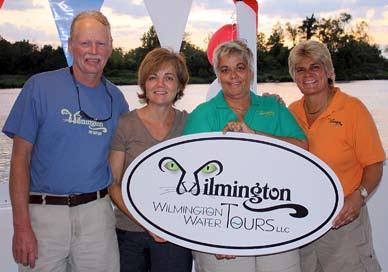
Planet Ocean Seminar Series at CMS
The UNCW Center for Marine Science (CMS) offers four distinguished lecture seminars each academic year, featuring prominent speakers from UNCW faculty and other leading research institutions, from well-known environmental organizations, and from government agencies. The 2010-2011 Planet Ocean Seminars will be:
September 14, 2010
Climate Change: Where Are We Now?
Dr. Otis B. Brown
NC State University and NOAA’s National Climatic Data Center
November 9, 2010
Mitigate, Adapt, or Suffer?
Preparing North Carolina’s Coasts for a Changing Climate
Dr. John Rummel
East Carolina University
February 8, 2011
Climate Change or Coastal Change?
The Future of the Carolina Coast
Dr. Douglas Gamble
UNC Wilmington Department of Geography and Geology
April 12, 2011
Responding to Climate Change
Dr. Larry Cahoon
UNC Wilmington Department of Biology and Marine Biology
The Series is free and open to the public. Due to limited seating, reservations are required. To make reservations or for more details, please call (910)962-2301.
Join the Bluefish Society

The Bluefish Society is the annual giving program of the UNCW Center for Marine Science. All Bluefish Society funds are used for CMS public outreach efforts, helping to defray operating costs for the Planet Ocean Seminar Series and other community enrichment programs. Annual memberships are $75 for individuals; $150 for couples; $200 for families. Member benefits include invitations to special events, and the opportunity to interact with world-renowned scientists and other environmental experts featured at Planet Ocean Seminars. For information about joining the Bluefish Society, call (910)962-2301 or visit http://uncw.edu/cms.
Osher Lifelong Learning Institute

The Osher Lifelong Learning Institute (OLLI) at UNCW is one of 120 prestigious institutes founded by Bernard Osher since 1997 for seasoned learners aged 50 and older. Since 2005 the Bernard Osher Foundation has awarded the Osher Lifelong Learning Institute at UNCW $1.35 million to continue to expand its educational and cultural programming. Becoming a member of OLLI, which costs $50/year or $30/semester, offers benefits including access to Randall Library and discount prices for classes and special events.
Science and Environmental Academy
Science and Environmental Academy (SEA and Coffee) meets weekly to present relevant environmental and science information. UNCW professors and knowledgeable community presenters share their expertise and offer opportunities for enjoyable interaction in a friendly, relaxed setting.
Sept 23 Bird-friendly Habitat Award Program with Charley Winterbauer, Cape Fear Audubon Society
Sept 30 The Karen Beasley Sea Turtle Rescue and Rehabilitation Center with Jean Beasley, Executive Director
Oct 7 Climate Change and Sea Level
Rise – What’s in it for North Carolina with Lawrence Cahoon, Ph.D., Center for Marine Science
Oct 14 Dive into the NC Aquarium at Fort Fisher with Joanne Harcke, Conservation and Research Coordinator
Oct 21 Agriculture and Health: an Historical Perspective with Leslie Hossfeld, Ph.D., sociology and criminal justice
Oct 28 Nuclear Energy in the 21st Century with Brian Triplett, GE Hitachi Nuclear Energy
Nov 4 Nature Photography with Chuck Carmack, Nature Photographer
Nov 11 Critical Issues in Environmental Anthropology with William Alexander, Ph.D., anthropology
Nov 18 Sustainable Biofuels with Matt Collogan, Airlie Gardens
Dec 2 The Gulf Stream: Exploring One of the Ocean’s Greatest Rivers with John Morrison, Ph.D., physics and physical oceanography
Dec 9 Fish Restoration of the Cape Fear River with Doug Springer, Cape Fear Riverkeeper®
Dec 16 The Plight of Coral Reefs in the 21st Century: Climate Change and More with Alina Szmant, Ph.D., marine biology
Registration Begins September 1! Visit www.uncw.edu/olli for class details or to register, or call (910)962-3195.
WIN: Wednesdays in Nature
Based on the success of SEA and Coffee, a new weekly series is being launched in Leland, covering the nature, beauty and history of the Cape Fear region.
Sept. 22 Cape Fear River Keepers with Doug Springer, Cape Fear Riverkeeper
Sept. 29 Improved Fish Passage at Lock and Dam #1, Cape Fear River, with Frank Yelverton, Army Corps of Engineers Fisheries Biologist
Oct. 6 History of the Wilmington Harbor with Beverly Tetterton, Local History Librarian, New Hanover County Library
Oct 13 Ecosystems of the Cape Fear River Basin with Captain Joe Abatte, Cape Fear Naturalist
Oct 20 Changes in the Cape Fear River, Economic and Environmental Impact of Sea Level Rise
with Jim Leutze, chancellor emeritus, UNCW
Oct 27 Conserving Biological Diversity in the Southeast Coastal Plain with Dan Ryan, Project Director for The Nature Conservancy
Nov 3 Pollution Problems in Wilmington with Michael Mallin, Center for Marine Sciences
Nov 10 What’s Up With Birds: Bird-Watching With a Purpose with Andy Wood, NC
Audubon Society
Registration Begins September 1!
Visit www.uncw.edu/olli for class details or to register, or call (910)962-3195.
The Pathways course catalog detailing current semester offerings is available at the new OLLI building, located at 620 S. College Road, Wilmington. It can also be viewed online.
education & business news
Emerging Green Business Conference
The Wilmington-Cape Fear Home Builders Association will host its 2010 Emerging Green Business Conference on Wednesday, September 15 from 9a.m.–3p.m. at Shell Island Resort, Wrightsville Beach. The Conference will highlight emerging green industries and innovative technology in a number of areas including solar energy, nuclear energy, water resources, recycling and solid waste. Attendees will be able to talk with key federal, state and private partners, which can assist growing green businesses and green job creation through identifying available capital resources.
This conference is ideal for those with a business or product idea that lacks capital required to get to market, as well as those with a current business they want to grow in a sustainable manner. To learn more see www.wcfhba.com or call (910)799-2611.
Entrepreneurship Summit
The 2010 NC Entrepreneurship Summit is a collaborative of leadership from across the state on a mission to create “homegrown” jobs. This year’s summit, “Keys to NC’s Economic Future,” will be the fourth state-wide gathering to celebrate and work for small businesses and highgrowth entrepreneurs. The Summit will be held September 19–20, 2010 at the Hilton Wilmington Riverside. Visit www.ncentresummit.org/ for details or to register.
Solar + Green Building Tour
Cape Fear Green Building Alliance will host its 6th Annual Solar and Green Building Tour on Saturday, September 25, from 10:00a.m.–3:00p.m. Visit “the greenest home in America,” 3404 Talon Court, and other high performance buildings in our area. The Talon Court residence has been featured in USA Today, EcoHome and Green Source. A tour of this house alone is worth the price of admission: $12 for CFGBA members and $15 for non-members. See www.cfgba.org for details.
2010 Green Living Conference and Expo
Wednesday, October 13, Cape Fear Green Building Alliance, the Greater Wilmington Business Journal and Wilma
Magazine present the second annual Green Living Conference and Expo. The event will feature an exhibition hall, keynote luncheon and classes for green builders, the public and businesses exploring sustainable initiatives. For information about sponsorships and exhibit spaces, contact Judy Budd at (910)343-8600, ext. 212. For information on classes, visit www.cfgba.org.
Student Milestones
Nicole Carpenter graduated from UNCW in December 2009 with a degree in Environmental Science and minors in biology and chemistry. She is now employed by CZR Incorporated, a woman-owned environmental consulting company headquartered in Jupiter, Florida and serving the southeast. Carpenter works as a field biologist out of CZR’s Wilmington office.
Shar Olivier, a principal of Biofuel Advance Research and Development, LLC. (BARD), has been accepted into the Nicholas School of the Environment at Duke University where she is in the Duke Environmental Leadership Master of Environmental Management (DEL-MEM) Program. http://www.nicholas.duke.edu/
After a summer working at Sapona Green Building Center, Alyssa Halle has left Wilmington for Blacksburg, Virginia. She is enrolled in the dual masters degree program: Masters of Public Administration and Masters of Urban & Regional Planning at Virginia Polytechnic Institute and State University.
Pender Early College Competes in NC Envirothon Program
The North Carolina Envirothon is an annual competition in which high school and middle school teams compete for recognition and prizes by demonstrating their knowledge of environmental science and natural resource concepts. Hard work by the Pender Early College High School students, team Bueno es Verde, qualified them to compete at the state level in this year’s competition. Four students travelled to Burlington, NC to compete against fifty other schools across the state at Cedar Rock Park. The program encourages students to develop a basic science background knowledge of our natural resources so they can make good environmental decisions as adults. www.ncenvirothon.org.
Actuary Alan Jameson uncovers a plot that threatens to blow the life insurance industry sky-high! Follow his adventures in this elegantly-plotted murder mystery.

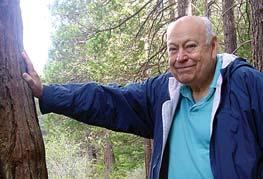
pages; $14.95
Follow us on Facebook
plated ways for ordinary people to survive what I believe we’re headed for: a breakdown of the global economic order in which we Americans function as the great
DOWNTOWN DELIVERS
Bicycle Courier Service

910-465-4117
8:00am – 3:00pm Weekdays
www.staythereillbringittoyou.com
Documents • Restaurant Orders • Groceries Waterproof and Insulated • Fast and Green!
18www.goinggreenpublications.com
and accommodate the production of bartered goods and services as well as cash-based income. Some combination of self-sustenance, direct exchange and cashgenerating activity will be needed to build a sustainable economy within the disintegrating but still-dominant economic order.
ited production capacity and vulnerability to psychological and economic isolation. In a future column, I’ll explore partnering with others to establish a modern-day “cottage industry” at your ecological house.
green building
Mother and Daughter Both Honored by YWCA
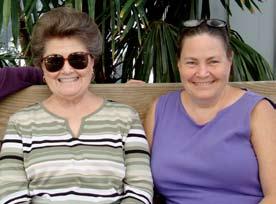
You can provide many types of services at or from your home. For example, in Oakland, California, where many people have long been pressed to provide extra income for their families, I’ve seen garages converted into barber shops, bakeries and even a Red-Wing shoe store. Today’s home businesses include all types of internet-
June 10
is the deadline for our Summer 2010 issue
Editor@goinggreenpublications.com or call (910)547-4390
It was a first for the Cape Fear YWCA: a mother and daughter were honored as 2010 Women of Achievement in their respective fields. Adeline Robertson, Ph.D, was honored in the Business category for founding Choice Caregivers, Inc.; her company provides long-term health care providers to allow people to stay in their own home with dignity. Her daughter, Cape Fear’s Going Green publisher Valerie Robertson, received her award in the Environmental category. To learn more about Choice Caregivers, Inc. call Adeline Robertson at (910)790-3376. For a list of all this year’s award recipients, visit YWCALowerCapeFear.org.
Soil to Soul Opens
Soil to Soul is the new place to learn about all things sustainable and self-sufficient. The brainchild of Mary Margaret Folds, Nicole Lancaster, and Evan Folds, Soil to Soul will follow an evolving business model based on the premise of “Coopetition.” It will encourage alternatives to the depructive business model built on competition and profit at all costs. Soil to Soul is located in Wilmington at 6005 Oleander Drive in the Progressive Gardens building.
CFGBA Offers Building Performance
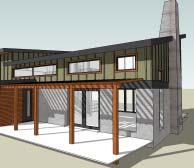

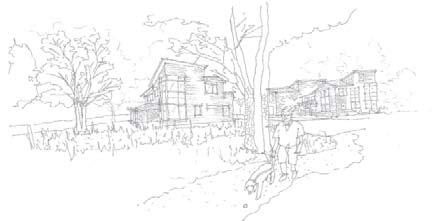
© Philip S. Wenz, 2009 Philip S. (Skip) Wenz is a freelance writer specializing in ecological design issues. He was a general contractor, residential designer, teacher and writer in the San Francisco Bay Area. In the early 1990s he founded, and for ten years directed, the Ecological Design Program at the San Francisco Institute of Architecture. He also teaches “Creating Your Ecological House” at Berkeley’s Building Education Center and wrote the book, Adding to a House (Taunton Press, 1995).
Skip now lives with his wife, Pam, in Corvallis, Oregon and divides his time between various writing projects and retrofitting his older home to be more environmentally friendly. He may be reached by email through his Web site at www.your-ecological-house.com.
Presented by the Cape Fear Green Buillding Alliance (CFGBA), The Building Performance Workshop Series is scheduled to begin on May 12. Made possible in part by a grant award from the NC Green Business Fund and ARRA, the series of professional trainings combines classroom instruction with on-site, hands-on demonstrations. The principles and techniques taught during the trainings apply to both new and existing construction, but special focus will be placed on their application to existing homes. The curriculum is tailored to prepare trainees for certifications and jobs in the emerging home retrofit industry.
September Classes at Soil to Soul


Classes will be held at Soil to Soul. Preregister at (910)920-9890 or visit soiltosoulonline.com


Wednesday 9/15/10 & 9/29/10
Wheatgrass 101: Learn benefits of wheatgrass and how to grow and juice your own. Class 6-7pm; Cost of $40 includes wheatgrass kit.
Saturday 9/11/10
During the on-site training sessions, trainees will be able to apply the techniques they learn in the classroom to existing homes. These green retrofits are being performed through a collaboration with Wilmington Area Rebuilding Ministries (WARM), a non-profit organization that performs repairs on the homes of economically disadvantaged individuals.
(910)470-5697
Hydroponics 101: Learn about indoor growing and hydroponics. Time: 11-12 noon. Cost $10.

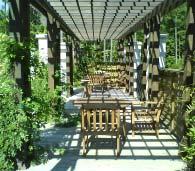
Saturday 9/18/10
Composting 101: Learn how, why, and what to compost! 11am-12noon. Cost is $10, discounts on composters.
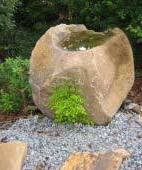
Saturday 9/25/10
Additional grant partners are Building Performance Specialists (BPS) and Sapona Green Building Center. BPS will provide instruction, energy audits and project management for the retrofits. Sapona will act as purchasing agent and materials supplier.
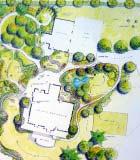
The is a non-profi the mission building CFGBA through industry public. second informational and open
Kombucha 101 and Tasting!: Come learn the benefits of this fizzy fermented elixir, and taste for yourself! 4-5:30pm. Cost is $15, discounts on kombucha kits.
General registration is now open. The complete list of workshop topics and dates is posted below:
May 12 – Building Science/ House Characterization
Beginning Thursdays in September, 9/9/10
Ashtanga with Larry Hobbs. Class is at 8:30am10ish, by donation.
continued from page 12
faith-based environmentalism
Cape Fear Citizens for a Safe Environment
ty to learn beekeeping and to stay up-to-date on successful beekeeping. email: methods.gldeagle@bellsouth.net
Cape Fear River Watch
Dogwood Alliance
Join the Ten Percent Challenge to Save Energy
Organized to fight the building of Hugo Neu landfill, now encouraging legislation to strengthen landfill regulations in North Carolina.
Environmental education, advocacy and action for the Lower Cape Fear River basin. www.cfrw.us
Carolina Farm Stewardship Association
2010 Critical Issues Seminar
www.stopthedump.com
Cape Fear Climate Action Network
A local citizen network providing support, advocacy, and recognition for climate action initiatives in the Cape Fear region. www.capefearcan.com
Cape Fear Cyclists
The information hub for Southeastern cyclists! www.capefearcyclists.org
Many congregations nation-wide have signed up for the 10% Challenge to Save Energy, working to reduce their congregation’s carbon footprint. Participants in thirty states are doing everything from installing energy efficient lighting to planting trees and native landscaping, to encouraging members to walk or carpool to services.
Carolina Farm Stewardship Association’s mission is to promote local and organic agriculture in the Carolinas by inspiring, educating and organizing farmers and consumers. Produces Carolina Guide to Local & Organic Food. www.carolinafarmstewards.org
Center for Environmental Farming Systems
Pledge to reduce your congregation’s carbon footprint by 10% will be experts with the EPA Energy Star for Congregations program as well as congregation leaders who have successfully completed projects to save energy. If you aren’t sure how or whether your congregation can participate in the Challenge, this is an opportunity to hear what others are doing, share ideas, and ask questions.
Nonprofit works to educate people about the importance of forests and the negative environmental impacts of business-as-usual paper production. Having achieved systemic change throughout the paper industry through public campaigns against office super stores--the largest retail paper sellers in the U.S.--they are now addressing protection for Southern forests and forests all over the world.
www.dogwoodalliance.org
Earth Day Alliance
Organizers of the Lower Cape Fear Celebration of Earth Day.
www.wilmingtonearthday.com
Cape Fear Community College (CFCC)
Architectural technology curriculum. www.cfcc.edu/programs/at
Cape Fear Economic Development Council (CFEDC)
Organizers encourage participants to help speed the transition to a clean energy future by working to reduce their congregation’s footprint 10% by 10/10/10.There will be a free Q&A webinar September 14, for friends of Interfaith Power & Light and participants in the Challenge. On the call
The Center for Environmental Farming Systems (CEFS) develops and promotes food and farming systems that protect the environment, strengthen local communities, and provide economic opportunities in North Carolina and beyond. CEFS is one of the nation’s largest centers for the study of environmentally sustainable farming practices.
www.cefs.ncsu.edu
CFEDC is an all-volunteer endeavor promoting innovation, creativity and entrepreneurship as essential to successful local economic growth, regional competitiveness, and jobs and income generation.
lnterfaith Power & Light is a national campaign of The Regeneration Project, which is an interfaith ministry devoted to deepening the connection between ecology and faith. For more information, contact Executive Director Susan Stephenson at action@theregenerationproject.org or call (415) 561-4891.
City of Wilmington Stormwater Services
Pathways Conference Yields Email Connections
www.capefearedc.org
Cape Fear Green Building Alliance (CFGBA)
Promotes the construction of environmentally responsible, profitable, healthy places to live and work.
www.cfgba.org
Cape Fear Museum of History and Science
Oldest museum in North Carolina tells stories of the region’s history, science and cultures through exhibition and educational programs. www.capefearmuseum.com
Cape Fear Regional Beekeepers Association
Church of the Servant held its annual Pathways conference in February, and this year’s topic was “Pathways to a Greener Planet.” Keynote speaker Beth Norcross offered ideas on how a congregation can start to determine their own approach to becoming more environmentally conscious. The following day, she lead a session on designing a creation care program at one’s own place of worship. Members of the community gave presentations sharing how they incorporate environmentalism into their own work and life.
Newly-formed chapter of the North Carolina State Beekeepers Association. Receive personal advice from beekeepers in the local communi-
During the conference, attendees realized it would be helpful for members of area faith-based organizations to be in communication with other groups to share
North Carolina Interfaith Power & Light is seeking a new director. The position announcement is posted at the NC IPL website: www.ncipl.org.
•
•
•
Oct. 12
•
•
is the deadline for our fall Green Building issue
Send your news to:
Editor@goinggreenpublications.com or call (910)547-4390
Maintains and improves the City’s stormwater drainage system for the protection of the community and the environment. Provides comprehensive stormwater management that takes into account both the quantity and quality of stormwater runoff. Stormwater education, outreach, and public involvement are important components of this mission.
www.wilmingtonnc.gov
information about becoming more green. A listserv named ILM-green-faith has now been established, available to anyone in the Wilmington faith community interested in environmental stewardship.
Coastal Conservation Association (CCA)–Cape Fear Chapter
The purpose of Coastal Conservation Association of North Carolina is to advise and educate the public on conservation of marine resources. The objective of CCA is to conserve, promote and enhance the present and future availability of these coastal resources for the benefit and enjoyment of the general public.
www.capefearcca.com
Anyone can subscribe to receive these mailings for free: visit http://lists.uncw. edu/mailman/listinfo/ilm-green-faith. Subscribers receive occasional emails and are also allowed to post information of interest to the group. If you have questions about how it works, you can email the person managing the list at ilm-greenfaith-owner@lists.uncw.edu.
Electric Vehicle Automobile Association (EVAA) – Coastal Carolinas / Wilmington
Local chapter provides e-mail of current developments and legislation
www.eaaev.org or e-mail: pagepaterson@mac. com
(continued on page 14)
The North Carolina Council of Churches will hold its Critical Issues Seminar on Thursday, October 14 at the Congregational United Church of Christ in Greensboro, NC. The theme for this year’s seminar is “Loving God’s Creation: Fully Integrating Creation Care with the Church’s Mission and Ministry.” Rev. Canon Sally Bingham, founder of Interfaith Power & Light, will be the keynote speaker. Cost for the day is $25, which includes lunch ($15 for students) and some scholarship assistance is available. Call (919)828-6501 for more information or to register.
Harvesting Rain Water can help you:

• Save money and energy
• Preserve precious resources
• Meet your sustainability goals
Call or visit us today to find out what Rain Water Harvesting can do for you: www.CFGreenSolutions.com


910.763.1630
Residential • Commercial • Industrial
928 No. 4th Street, Wilmington, NC
Pledge to Take A Child
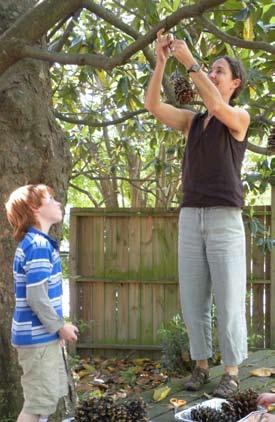
Outside
September 24—September 30

Take A Child Outside Week is a program designed to help break down obstacles that keep children from discovering the natural world. By arming parents, teachers and other caregivers with resources for outdoor activities, the goal is to help children across the country develop a better understanding and appreciation of the environment in which they live, and a burgeoning enthusiasm for its exploration. Visit www.takeachildoutside.org to find local activities and see a map of participants. Pledge to take a child outdoors, and share your experience with others!
Products for Building Green Communities

Robbie Sutton has launched a new company, Carolina Green Building, located at 928 N. 4th Street in downtown WIlmington. Carolina Green Building will offer solar, geothermal, and energy efficiency products in the Carolinas. The company’s mission is to combine professional contracting, quality engineering, and environmental stewardship to aide their clients’ green ventures.
Carolina Green Building is fully licensed, trained, and certified to design, install, and service any renewable energy system. The company has retained a full complement of contractors to ensure that systems are installed by specialized technicians for maximum performance.
Learn more at www.carolina-green. com or contact Sutton at (910)233-4798 or Robbie@carolina-green.com.


stormwater 101
Did You Drop Something?
Wilmington Adopts New Pet Waste Disposal Ordinance
by Jennifer ButlerI got asked once by a Wilmington resident why the city was educating citizens to clean up after their pets, because the “deer, raccoons and wild animals don’t have anyone cleaning up after them.” Good question! When this area was minimally developed with little impervious surface coverage, even with a lot more wild animals roaming around, we had crystal-clear, healthy creeks and waterways. Fifty years later, this area has had an explosion of impervious surfaces, polluted stormwater runoff, domestic animals—and waterways that are suffering the impact. And pet waste is a large contributor.
A 2006 survey of North Carolinians found that only one third of residents were aware that stormwater runoff—and any pollution in it—flows directly to the nearest waterway without being treated. It’s alarming to think that two-thirds of residents think stormwater is treated, yet
perhaps this explains why some folks don’t think picking up after their pet is all that important. Perhaps they are unaware that leaving pet waste on the ground allows harmful bacteria, parasites, and nutrients to wash into waterways when it rains—the same waterways we use for swimming, drinking, fishing, boating, kayaking, and surfing. In fact, most of our tidal creek waterways are now partly or fully closed to shellfishing because of bacterial pollution.
It’s enlightening to consider the problem of pet waste from a simple volume standpoint. In 2008, there were nearly 34,000 registered dogs in New Hanover County. Veterinary sources estimate that a dog produces an average of 3/4 to 2 pounds of waste per day. Using the conservative figure of 3/4 pounds of waste, multiplied by 34,000 dogs, means 25,500 pounds or nearly 12.5 tons of dog waste is generated per day in New Hanover County. That’s enough dog waste to fill 331 full-size
Wilmington’s New Pet Waste Ordinance Pet Owner Requirements
Requirements in Public:
• Fully and immediately clean up after pets on any public property. (Public property consists of streets, sidewalks, right of ways, parks, plazas, stream banks, public accesses, pathways, drainageways, storm drains, creeks, officially accepted easements, etc.)
• Carry a clean-up device (i.e. bag, scooper) at all times and be able to show the clean-up device to a Code Enforcement Official, if asked.
• Bag and dispose of pet waste in a closed trash receptacle or refuse container. It is allowed in the landfill.

• NEVER flush pet waste down the toilet because it creates blockages in the sanitary sewer treatment system and disrupts the normal waste treatment process (Cape Fear Public Utility Authority ordinance).
Suggestions for Home:
• Pick up pet waste at your residence to prevent bacteria and nutrients from harming waterways and public health.
• If you hire a pet waste removal service for your yard, be sure the waste is picked up regularly. It’s a bad idea to leave bacterialaden pet waste on the ground too long. Apartment complexes and HOAs should encourage residents to clean up after their pets by adopting/enforcing a pet waste policy.
• Install a pet waste digester on your property; it’s like a mini-septic system for pet waste.
• Bury waste in a hole that is at least 6” deep and away from gardens, wells, ditches, storm drains and waterways.
• Waste from cats and other pets that “use the restroom outdoors” should also be collected. Provide a covered litter box outside, then place the used kitty litter in a bag in the trash.
• NEVER flush pet waste or kitty litter down the toilet (CFPUA ordinance), compost it, dump it in storm drains or ditches, or leave it on the ground.
garbage trucks each year. This total doesn’t account for unregistered dogs, cats, other pets, wild animals and birds that contribute even more fecal waste to the outdoor environment each day.
Pathogens in pet waste are a health hazard for anyone, but can be especially harmful to children, the elderly, and persons with weakened immune systems. While you may not actually witness a pile of pet waste floating into the nearest storm drain, when it rains, its cocktail of bacteria, parasites and nutrients is washing directly into your nearby creek. Here’s a sampling of diseases and infections that can be transmitted to humans from uncollected pet waste:
Salmonellosis– Common bacterial infection transmitted to humans by other animals. Symptoms include fever, muscle aches, diarrhea, headache, vomiting, abdominal cramps and even death.
Campylobacteriosis– Bacterial infection carried by dogs and cats that causes diarrhea, cramping, abdominal pain and fever in humans.
Toxoplasmosis– Parasite carried by cats that can cause birth defects such as mental retardation and blindness if a woman becomes infected during pregnancy. Also a problem for people with suppressed immune systems.
(continued on page 24)
Stormwater 101
continued from page 23
Toxocariasis– Infection caused by parasitic roundworms that can cause blindness or temporary vision loss, rash, fever, cough and pneumonia.
Pet waste can also cause conditions such as tuberculosis, e.coli contamination, cryptosporidiosis, and giardiasis

In addition to directly endangering our health, the pollution from pet waste can also result in swimming advisories, closed shellfishing waters, and impaired aquatic habitat. Nutrients in pet waste can cause algae and weeds to grow out of control. This nutrient-rich water can upset the ecological balance of our waterways, leading to low-oxygen situations and ultimately to fish kills. Disposing of pet waste properly can help keep local waterways suitable for swimming, fishing, drinking, and other activities.
Protecting our health and our waterways should be sufficient motivation for

most to clean up after the family pet. It’s good to become familiar with the newlyenacted pet waste ordinance (see page 23) as non-compliance can carry a hefty fine.
We may not have control over all the pollutants running into our waterways, but we can pick up after our dogs—and it’s part of being a responsible pet owner.
Jennifer Butler is the Stormwater Education Program Coordinator for the City of Wilmington Stormwater Services. She, her husband and their dogs enjoy quiet walks through the park near their home—and they always have plenty of doody pick-up bags handy.
Editor’s note: 12.5 tons of waste plus plastic bags is a lot to add to our already overtaxed landfills. When possible, consider installing a pet waste digester on your property. One of the benefits of living on sand: it’s easy to dig the required hole.
Cape Fear’s
Vote for the Environment
Two upcoming events offer the chance to hear candidates’ positions on environmental issues, prior to elections.
Cape Fear Green Building Alliance
Wednesday, September 8 at 6:30p.m.
The focus is on environmental issues, as the Cape Fear Green Building Alliance hosts the candidates for NC Senate District 9, NC State House District 16, NC State House District 18 and New Hanover County Commissioners. All candidates in these races were invited to participate. The following candidates have accepted:
• Jim Leutze and Thom Goolsby
• F.D. Rivenbark and Carolyn Justice
• Susi Hamilton and Beth Dawson
• Deborah Butler, Sid Causey, Rick Catlin and Brian Berger
Doors open at 6:30 p.m. for networking and the program begins at 7:00 p.m. The Balcony, corner of Front and Dock Streets, third floor, Wilmington, NC. See details at www.cfgba.org or call (910)470-5697.
Cape Fear Economic Development Council
Tuesday, September 28 at 6p.m.
The Cape Fear Economic Development Council will present a panel discussion, with School Board representatives discussing education and economics.
WHQR Gallery, 254 N. Front Street, third floor, Wilmington, NC. See details at http://capefearedc.org.
